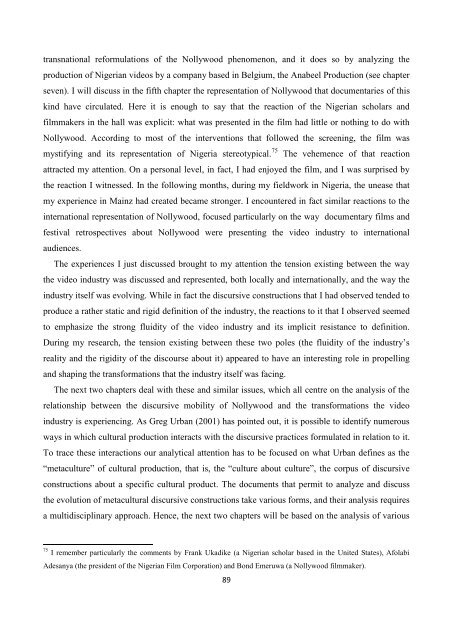Create successful ePaper yourself
Turn your PDF publications into a flip-book with our unique Google optimized e-Paper software.
transnational reformulations of the Nollywood phenomenon, and it does so by analyzing theproduction of Nigerian videos by a company based in Belgium, the Anabeel Production (see chapterseven). I will discuss in the fifth chapter the representation of Nollywood that documentaries of thiskind have circulated. Here it is enough to say that the reaction of the Nigerian scholars andfilmmakers in the hall was explicit: what was presented in the film had little or nothing to do withNollywood. According to most of the interventions that followed the screening, the film wasmystifying and its representation of Nigeria stereotypical. 75 The vehemence of that reactionattracted my attention. On a personal level, in fact, I had enjoyed the film, and I was surprised bythe reaction I witnessed. In the following months, during my fieldwork in Nigeria, the unease thatmy experience in Mainz had created became stronger. I encountered in fact similar reactions to theinternational representation of Nollywood, focused particularly on the way documentary films andfestival retrospectives about Nollywood were presenting the video industry to internationalaudiences.The experiences I just discussed brought to my attention the tension existing between the waythe video industry was discussed and represented, both locally and internationally, and the way theindustry itself was evolving. While in fact the discursive constructions that I had observed tended toproduce a rather static and rigid definition of the industry, the reactions to it that I observed seemedto emphasize the strong fluidity of the video industry and its implicit resistance to definition.During my research, the tension existing between these two poles (the fluidity of the industry’sreality and the rigidity of the discourse about it) appeared to have an interesting role in propellingand shaping the transformations that the industry itself was facing.The next two chapters deal with these and similar issues, which all centre on the analysis of therelationship between the discursive mobility of Nollywood and the transformations the videoindustry is experiencing. As Greg Urban (2001) has pointed out, it is possible to identify numerousways in which cultural production interacts with the discursive practices formulated in relation to it.To trace these interactions our analytical attention has to be focused on what Urban defines as the“metaculture” of cultural production, that is, the “culture about culture”, the corpus of discursiveconstructions about a specific cultural product. The documents that permit to analyze and discussthe evolution of metacultural discursive constructions take various forms, and their analysis requiresa multidisciplinary approach. Hence, the next two chapters will be based on the analysis of various75 I remember particularly the comments by Frank Ukadike (a Nigerian scholar based in the United States), AfolabiAdesanya (the president of the Nigerian Film Corporation) and Bond Emeruwa (a Nollywood filmmaker).89
















